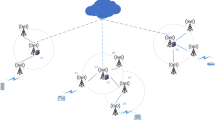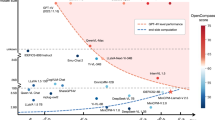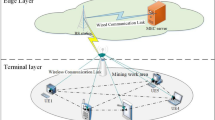Abstract
Generative artificial intelligence (GenAI) has brought about profound transformations across the diverse domains of the Internet of Things such as manufacturing, marketing, medicine, education and work assistance. However, the proliferation of computationally intensive and highly complex GenAI models poses substantial challenges to servers and central network capacities. To effectively permeate various facets of our lives, GenAI heavily relies on mobile edge computing. In this Perspective article, we first introduce GenAI applications on edge devices highlighting its potential capacity to revolutionize our everyday life. We then outline the challenges associated with deploying GenAI on edge devices and present possible solutions to effectively address these obstacles. Finally, we introduce an intelligent mobile edge computing paradigm able to reduce response latency, improve efficiency, strengthen security and privacy preservation and conserve energy, opening the way to a sustainable and efficient application of the different GenAI models.
This is a preview of subscription content, access via your institution
Access options
Subscribe to this journal
Receive 12 digital issues and online access to articles
$119.00 per year
only $9.92 per issue
Buy this article
- Purchase on SpringerLink
- Instant access to full article PDF
Prices may be subject to local taxes which are calculated during checkout

Similar content being viewed by others
References
Altman, R. et al. Generative AI: Perspectives from Stanford HAI. Stanford University https://hai.stanford.edu/sites/default/files/2023-03/Generative_AI_HAI_Perspectives.pdf (2023).
Kingma, D. P. & Welling, M. Auto-encoding variational bayes. In 2nd International Conference on Learning Representations (ICLR, 2014).
Goodfellow, I. J. et al. Generative adversarial nets. Adv. Neural Inf. Process. Syst. 3, 2672–2680 (2014).
van den Oord, A., Kalchbrenner, N. & Kavukcuoglu, K. Pixel recurrent neural networks. In Proc. 33rd International Conference on Machine Learning (eds Balcan, M. F. & Weinberger, K. Q.) 1747–1756 (ICML, 2016).
Ho, J., Jain, A. & Abbeel, P. Denoising diffusion probabilistic models. In Advances in Neural Information Processing Systems Vol. 33 (eds Larochelle, H., Ranzato, M., Hadsell, R., Balcan, M. F. & Lin, H.) 6840–6851 (Curran Associates, Inc., 2020).
Stokes, J. M. et al. A deep learning approach to antibiotic discovery. Cell 180, 688–702.e13 (2020).
Devlin, J., Chang, M.-W., Lee, K. & Toutanova, K. BERT: pre-training of deep bidirectional transformers for language understanding. In Proc. 2019 Conference of the North American Chapter of the Association for Computational Linguistics: Human Language Technologies Vol. 1 (eds Burstein, J., Doran, C. & Solario, T.) 4171–4186 (ACL, 2019).
Touvron, H. et al. LLaMA: open and efficient foundation language models. Preprint at arXiv https://doi.org/10.48550/arXiv.2302.13971 (2023).
Bubeck, S. et al. Sparks of artificial general intelligence: early experiments with GPT-4. Preprint at arXiv https://doi.org/10.48550/arXiv.2303.12712 (2023).
Ramesh, A. et al. Zero-shot text-to-image generation. In Proc. 38th International Conference on Machine Learning (eds Meila, M. & Zhang, T.) 8821–8831 (PMLR, 2021).
Girdhar, R. et al. ImageBind one embedding space to bind them all. In Proc. IEEE Computer Society Conference on Computer Vision and Pattern Recognition 15180–15190 (IEEE, 2023).
Pichar, S. & Hassabis, D. Introducing Gemini: our largest and most capable AI model. Google https://blog.google/technology/ai/google-gemini-ai (2023).
OpenAI. Creating video from text. https://openai.com/sora (2024).
An, J., Ding, W. & Lin, C. ChatGPT: tackle the growing carbon footprint of generative AI. Nature 615, 586 (2023).
OpenAI. OpenAI API. https://openai.com/blog/openai-api (2020).
OpenAI. Introducing the GPT Store. https://openai.com/blog/introducing-the-gpt-store (2024).
Ale, L., Zhang, N., Wu, H., Chen, D. & Han, T. Online proactive caching in mobile edge computing using bidirectional deep recurrent neural network. IEEE Internet Things J. 6, 5520–5530 (2019).
Mao, Y., You, C., Zhang, J., Huang, K. & Letaief, K. B. A survey on mobile edge computing: the communication perspective. IEEE Commun. Surv. Tutor. 19, 2322–2358 (2017).
Wang, S. et al. Delay-aware microservice coordination in mobile edge computing: a reinforcement learning approach. IEEE Trans. Mob. Comput. 20, 939–951 (2021).
Ale, L. et al. Delay-aware and energy-efficient computation offloading in mobile edge computing using deep reinforcement learning. IEEE Trans. Cogn. Commun. Netw. 7, 881–892 (2021).
Li, M., Gao, J., Zhao, L. & Shen, X. Deep reinforcement learning for collaborative edge computing in vehicular networks. IEEE Trans. Cogn. Commun. Netw. 7731, 1–14 (2020).
Holmes, A. & Gardizy, A. AI developers stymied by server shortage at AWS, Microsoft, Google. The Information https://www.theinformation.com/articles/ai-developers-stymied-by-server-shortage-at-aws-microsoft-google (2023).
Cave, S. & Cammers-Goodwin, S. in What Matters Most (ed. Morgan, A.) Ch. 17 (Cambridge University Press, 2024).
Chakraborty, C., Bhattacharya, M. & Lee, S.-S. Need an AI-enabled, next-generation, advanced chatGPT or large language models (LLMs) for error-free and accurate medical information. Ann. Biomed. Eng. 52, 134–135 (2023).
Llopis-Albert, C., Rubio, F. & Valero, F. Impact of digital transformation on the automotive industry. Technol. Forecast. Soc. Change 162, 120343 (2021).
Nicholls, L., Strengers, Y. & Sadowski, J. Social impacts and control in the smart home. Nat. Energy 5, 180–182 (2020).
Wu, H., Yan, Y., Sun, D. & Simon, R. A customized real-time compilation for motion control in embedded PLCs. IEEE Trans. Ind. Inform. 15, 812–821 (2019).
Véliz, C. Privacy and digital ethics after the pandemic. Nat. Electron. 4, 10–11 (2021).
Pundlik, S., Shivshanker, P. & Luo, G. Impact of apps as assistive devices for visually impaired persons. Annu. Rev. Vis. Sci. 9, 111–130 (2023).
Kamilaris, A. O. Geospatial analysis and the internet of things. ISPRS Int. J. Geo-Inf. 7, 269 (2018).
Gozalo-Brizuela, R. & Garrido-Merchán, E. C. A survey of generative AI applications. Preprint at arXiv https://doi.org/10.48550/arXiv.2306.02781 (2023).
Meena, Y. K. & Arya, K. V. Multimodal interaction and IoT applications. Multimed. Tools Appl. 82, 4781–4785 (2023).
Shi, W., Cao, J., Zhang, Q., Li, Y. & Xu, L. Edge computing: vision and challenges. IEEE Internet Things J. 3, 637–646 (2016).
Moor, M. et al. Foundation models for generalist medical artificial intelligence. Nature 616, 259–265 (2023).
Tyler, J., Choi, S. W. & Tewari, M. Real-time, personalized medicine through wearable sensors and dynamic predictive modeling: a new paradigm for clinical medicine. Curr. Opin. Syst. Biol. 20, 17–25 (2020).
Chen, C. et al. Deep learning based pedestrian inertial navigation: methods, dataset and on-device inference. IEEE Internet Things J. 7, 4431–4441 (2020).
Taniguchi, A., Hagiwara, Y., Taniguchi, T. & Inamura, T. Spatial concept-based navigation with human speech instructions via probabilistic inference on Bayesian generative model. Adv. Robot. 34, 1213–1228 (2020).
Park, J. S. et al. Generative agents: interactive simulacra of human behavior. In Proc. 36th Annual ACM Symposium on User Interface Software and Technology 1–22 (Association for Computing Machinery, 2023).
Li, J. et al. Towards ubiquitous personalized music recommendation with smart bracelets. Proc. ACM Interact. Mob. Wearable Ubiquitous Technol. 6, 125 (2022).
Kozyreva, A. et al. Public attitudes towards algorithmic personalization and use of personal data online: evidence from Germany, Great Britain, and the United States. Humanit. Soc. Sci. Commun. 8, 117 (2021).
Pataranutaporn, P. et al. AI-generated characters for supporting personalized learning and well-being. Nat. Mach. Intell. 3, 1013–1022 (2021).
Kubo, Y., Takada, R., Shizuki, B. & Takahashi, S. Exploring context-aware user interfaces for smartphone-smartwatch cross-device interaction. Proc. ACM Interact. Mob. Wearable Ubiquitous Technol. 1, 68 (2017).
Cipresso, P., Giglioli, I. A. C., Raya, M. A. & Riva, G. The past, present, and future of virtual and augmented reality research: a network and cluster analysis of the literature. Front. Psychol. 9, 2086 (2018).
Johnson, M. et al. Google’s multilingual neural machine translation system: enabling zero-shot translation. Trans. Assoc. Comput. Linguist. 5, 339–351 (2017).
Coldewey, D. Universal translator’ dubs and lip-syncs speakers — but Google warns against misuse. Techcrunch https://techcrunch.com/2023/05/10/universal-translator-dubs-and-lip-syncs-speakers-but-google-warns-against-misuse/?guccounter=1&guce_referrer=aHR0cHM6Ly93d3cuZ29vZ2xlLmNvbS8&guce_referrer_sig=AQAAAEDhitJGJbMhVC893e0JT78M57jNhJLsThEL07A1Wt0EZsLS4j2S-QrKqW2YIzyntOyCBZ5hTJnR0VWy9Cz_vxDMAWjYM-S7skFGOUYoje5A-RNoBdXYzuh8LEgBPkEG-TtCt2hGEbOCNjvr5IiDvvnBi-jYRx_dpqlT9EYzMbiX (2023).
Ghanvatkar, S., Kankanhalli, A. & Rajan, V. User models for personalized physical activity interventions: scoping review. JMIR mHealth uHealth 7, e11098 (2019).
Wackerhage, H. & Schoenfeld, B. J. Personalized, evidence-informed training plans and exercise prescriptions for performance, fitness and health. Sport. Med. 51, 1805–1813 (2021).
Zhang, C., Lakens, D. & Jsselsteijn, W. A. I. Theory integration for lifestyle behavior change in the digital age: an adaptive decision-making framework. J. Med. Internet Res. 23, 12–19 (2021).
Bharadwaj, H. K. et al. A review on the role of machine learning in enabling IoT based healthcare applications. IEEE Access 9, 38859–38890 (2021).
Espinoza, H., Kling, G., McGroarty, F., O’Mahony, M. & Ziouvelou, X. Estimating the impact of the internet of things on productivity in Europe. Heliyon 6, e03935 (2020).
Lecun, Y., Bengio, Y. & Hinton, G. Deep learning. Nature 521, 436–444 (2015).
Zhao, J. et al. GaLore: memory-efficient LLM training by gradient low-rank projection. Preprint at arXiv https://doi.org/10.48550/arXiv.2403.03507 (2024).
Brown, T. et al. Language models are few-shot learners. In Advances in Neural Information Processing Systems Vol. 33 (eds Larochelle, H., Ranzato, M., Hadsell, R., Balcan, M. F. & Lin, H.) 1877–1901 (Curran Associates, Inc., 2020).
Wang, L., Zhang, Y. & Bruce, P. G. Batteries for wearables. Natl Sci. Rev. 10, nwac062 (2022).
Curry, E. et al. Internet of things enhanced user experience for smart water and energy management. IEEE Internet Comput. 22, 18–28 (2018).
Al-Turjman, F. Energy-aware data delivery framework for safety-oriented mobile IoT. IEEE Sens. J. 18, 470–478 (2018).
Ogonji, M. M., Okeyo, G. & Wafula, J. M. A survey on privacy and security of Internet of Things. Comput. Sci. Rev. 38, 100312 (2020).
Landau, S. The real security issues of the iPhone case. Science 352, 1398–1399 (2016).
Chen, J. et al. IRAF: a deep reinforcement learning approach for collaborative mobile edge computing IoT networks. IEEE Internet Things J. 6, 7011–7024 (2019).
Sudharsan, B. et al. Toward distributed, global, deep learning using IoT devices. IEEE Internet Comput. 25, 6–12 (2021).
Ray, P. P. A review on TinyML: state-of-the-art and prospects. J. King Saud. Univ. Comput. Inf. Sci. 34, 1595–1623 (2022).
Barik, R. K., Dubey, H., Samaddar, A. B., Gupta, R. D. & Ray, P. K. FogGIS: Fog computing for big data analytics. In Proc. 2016 IEEE Uttar Pradesh Section International Conference on Electrical, Computer and Electronics Engineering (UPCON) 613–618 (IEEE, 2016).
Xu, Y. et al. Adaptive control of local updating and model compression for efficient federated learning. IEEE Trans. Mob. Comput. 22, 5675–5689 (2022).
Ale, L. Intelligent Mobile Edge Computing. PhD thesis, Texas A&M Univ. Corpus Christi (2021).
Abbas, N., Zhang, Y., Taherkordi, A. & Skeie, T. Mobile edge computing: a survey. IEEE Internet Things J. 5, 450–465 (2018).
Osterrieder, P., Budde, L. & Friedli, T. The smart factory as a key construct of industry 4.0: a systematic literature review. Int. J. Prod. Econ. 221, 107476 (2020).
Brand, J., Israeli, A. & Ngwe, D. Using GPT for market research. Working Paper No. 23-062. Harvard Business School https://www.hbs.edu/faculty/Pages/item.aspx?num=63859 (2023).
Kumar, Y., Koul, A., Singla, R. & Ijaz, M. F. Artificial intelligence in disease diagnosis: a systematic literature review, synthesizing framework and future research agenda. J. Ambient. Intell. Humaniz. Comput. 14, 8459–8486 (2023).
Gan, W., Qi, Z., Wu, J. & Lin, J. C.-W. Large language models in education: vision and opportunities. In 2023 IEEE International Conference on Big Data 4776–4785 (IEEE, 2023).
Brynjolfsson, E., Li, D. & Raymond, R. L. Generative AI at work. Working Paper No. 4141. Stanford Graduate School of Business https://www.gsb.stanford.edu/faculty-research/working-papers/generative-ai-work (2023).
Ale, L., Zhang, N., King, S. A. & Guardiola, J. Spatio-temporal Bayesian learning for mobile edge computing resource planning in smart cities. ACM Trans. Internet Technol. 21, 72 (2021).
Ale, L., King, S. A., Zhang, N., Sattar, A. R. & Skandaraniyam, J. D3PG: Dirichlet DDPG for task partitioning and offloading with constrained hybrid action space in mobile edge computing. IEEE Internet Things J. 9, 19260–19272 (2022).
Li, X. & Da Xu, L. A review of internet of things — resource allocation. IEEE Internet Things J. 8, 8657–8666 (2021).
Han, S., Mao, H. & Dally, W. J. Deep compression: compressing deep neural networks with pruning, trained quantization and Huffman coding. In 4th International Conference on Learning Representations (ICLR, 2016).
Hinton, G., Vinyals, O. & Dean, J. Distilling the knowledge in a neural network. In NIPS Deep Learning and Representation Learning Workshop (NIPS, 2015).
Yu, X., Liu, T., Wang, X. & Tao, D. On compressing deep models by low rank and sparse decomposition. In Proc. IEEE Conference on Computer Vision and Pattern Recognition 67–76 (IEEE, 2017).
Tang, H., Liu, Z., Li, X., Lin, Y. & Han, S. TorchSparse: efficient point cloud inference engine. In 7th Conference on Machine Learning and Systems (MLSys, 2022).
Jacob, B. et al. Quantization and training of neural networks for efficient integer-arithmetic-only inference. In Proc. IEEE Computer Society Conference on Computer Vision and Pattern Recognition 2704–2713 (IEEE, 2018).
Cai, H., Gan, C., Wang, T., Zhang, Z. & Han, S. Once-for-All: train one network and specialize it for efficient deployment. In 8th International Conference on Learning Representations (ICLR, 2020).
Liu, Z., Yang, X., Tang, H., Yang, S. & Han, S. FlatFormer: flattened window attention for efficient point cloud transformer. In Proc. IEEE Computer Society Conference on Computer Vision and Pattern Recognition 1200–1211 (IEEE, 2023).
McMahan, H. B., Moore, E., Ramage, D. & y Arcas, B. A. Federated learning of deep networks using model averaging. In Proc. 20th International Conference on Artificial Intelligence and Statistics 1273–1282 (PMLR, 2017).
Kumar, M. et al. A smart privacy preserving framework for industrial IoT using hybrid meta-heuristic algorithm. Sci. Rep. 13, 5372 (2023).
Siriwardhana, Y., Porambage, P., Liyanage, M. & Ylianttila, M. A survey on mobile augmented reality with 5G mobile edge computing: architectures, applications, and technical aspects. IEEE Commun. Surv. Tutor. 23, 1160–1192 (2021).
Cao, X., Wang, F., Xu, J., Zhang, R. & Cui, S. Joint computation and communication cooperation for energy-efficient mobile edge computing. IEEE Internet Things J. 6, 4188–4200 (2019).
Xu, Z., Jain, S. & Kankanhalli, M. S. Hallucination is inevitable: an innate limitation of large language models. Preprint at arXiv https://arxiv.org/abs/2401.11817 (2024).
Author information
Authors and Affiliations
Contributions
All authors contributed equally to the preparation of this manuscript.
Corresponding authors
Ethics declarations
Competing interests
The authors declare no competing interests.
Peer review
Peer review information
Nature Reviews Electrical Engineering thanks the anonymous reviewers for their contribution to the peer review of this work.
Additional information
Publisher’s note Springer Nature remains neutral with regard to jurisdictional claims in published maps and institutional affiliations.
Rights and permissions
Springer Nature or its licensor (e.g. a society or other partner) holds exclusive rights to this article under a publishing agreement with the author(s) or other rightsholder(s); author self-archiving of the accepted manuscript version of this article is solely governed by the terms of such publishing agreement and applicable law.
About this article
Cite this article
Ale, L., Zhang, N., King, S.A. et al. Empowering generative AI through mobile edge computing. Nat Rev Electr Eng 1, 478–486 (2024). https://doi.org/10.1038/s44287-024-00053-6
Accepted:
Published:
Issue date:
DOI: https://doi.org/10.1038/s44287-024-00053-6
This article is cited by
-
Lightweight deep learning for real-time road distress detection on mobile devices
Nature Communications (2025)
-
Seamless optical cloud computing across edge-metro network for generative AI
Nature Communications (2025)
-
An enhancing privacy training architecture for federal vehicle networking
Peer-to-Peer Networking and Applications (2025)
-
Privacy-preserving federated learning scheme for distributed smart grid based on multi-key homomorphic encryption
Peer-to-Peer Networking and Applications (2025)
-
Mobile AI: Communication and Mobility After the Smartphone
Communication and Change (2025)



